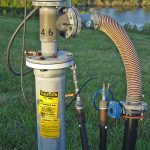A landfill gas (LFG) pin well is a short, narrow pipe inserted directly into the top of compacted waste at a landfill to quickly extract landfill gas (methane and carbon dioxide) for odour control or landfill gas extraction, especially in areas where drilling rigs are not feasible.
These wells are installed using a long rod to create an opening in the waste before a perforated pipe is placed inside. Pin wells are a cost-effective and efficient method for improving landfill gas capture and reducing methane emissions. Temporary cover will normally have been placed above the cell before the pin wells are inserted, although a temporary plastic membrane may also be used.
They are pushed or piled into the landfilled waste.
Landfill Gas Pin Wells: Key Points
- Pin wells are a cost-effective and efficient method for extracting landfill gas (LFG), making them an attractive option for waste management facilities.
- Traditional LFG extraction methods, such as vertical wells, often have limitations including high costs and complex installation processes.
- Pin wells offer an innovative solution by being easier to install and maintain, leading to lower operational costs and increased gas capture efficiency.
- Implementing pin wells can significantly reduce greenhouse gas emissions from landfills, contributing to environmental sustainability.
- Successful case studies demonstrate that pin wells can improve LFG recovery rates and support renewable energy projects.

“Pinwell Installation – Landfill Pipe …” from landfillpipe.co.uk and used with no modifications.
Fast Facts on Landfill Gas Pin Wells
Landfill gas pin wells represent a breakthrough in waste management technology. They are designed to improve the efficiency of landfill gas extraction while minimizing costs. By using pin wells, facilities can better capture and utilize the methane produced by decomposing waste. This not only reduces emissions but also transforms waste into a valuable energy resource.
Traditional methods of landfill gas extraction often involve complex and costly infrastructure. In contrast, pin wells are relatively simple to install and operate. This makes them an ideal choice for facilities looking to enhance their environmental performance without breaking the bank.
Why Pin Wells Are a Game Changer for Landfill Gas Extraction
The importance of pin wells in the realm of landfill gas extraction cannot be overstated. These wells offer a practical solution to many of the challenges faced by traditional extraction methods. With their innovative design, pin wells can significantly improve the capture and utilization of landfill gas, turning what was once a waste product into a source of renewable energy.
Traditional LFG Extraction Methods and Their Limitations
Traditional methods of extracting landfill gas typically involve vertical wells drilled deep into the waste mass. These wells are connected to a network of pipes that transport the gas to a processing facility. While effective, these systems can be costly and complex to install and maintain.
Besides that, traditional wells often face limitations in terms of gas capture efficiency. The depth and spacing of the wells can impact the amount of gas extracted, and the system's complexity can lead to operational challenges. As a result, many facilities struggle to maximize their LFG recovery rates.
Pin Wells: An Innovative Solution
Pin wells offer an innovative alternative to traditional LFG extraction methods. Unlike vertical wells, pin wells are smaller, shallower, and easier to install. This makes them a cost-effective solution for facilities looking to improve their gas capture efficiency.
Because of their design, pin wells can be installed more densely across a landfill site. This allows for more comprehensive gas capture, reducing emissions and increasing the amount of methane available for energy production. The simplicity of pin wells also means lower maintenance costs and fewer operational challenges.
By adopting pin wells, facilities can enhance their environmental performance and contribute to a more sustainable future. With their ability to improve LFG recovery rates and support renewable energy projects, pin wells are indeed a game changer in landfill gas extraction.
Considerations for Pin Well Installation
When planning to install pin wells, several factors must be considered to ensure optimal performance. The first step is to conduct a thorough site assessment. This involves evaluating the landfill's layout, waste composition, and existing gas collection infrastructure. Understanding these elements is crucial for designing a pin well system that maximizes gas capture efficiency.
Next, consider the spacing and depth of the pin wells. Unlike traditional wells, pin wells are typically installed closer together, allowing for more comprehensive gas extraction. However, the exact spacing and depth will depend on the specific characteristics of the landfill. It's essential to tailor the design to the site's unique needs.
Finally, plan for the integration of the pin wells with the existing gas collection system. This may involve connecting the pin wells to a network of pipes that transport the gas to a processing facility. Proper integration is key to ensuring seamless operation and maximizing the benefits of the pin well system.

Benefits of Using Pin Wells for LFG Extraction
Pin wells offer numerous advantages over traditional landfill gas extraction methods. By improving gas capture efficiency and reducing costs, they provide a compelling solution for waste management facilities looking to enhance their environmental performance.
Cost-Effectiveness and Efficiency
One of the most significant benefits of pin wells is their cost-effectiveness. Because of their simple design and ease of installation, pin wells are much less expensive to implement than traditional vertical wells. This makes them an attractive option for facilities with limited budgets.
Moreover, pin wells can be highly efficient at capturing landfill gas. Their dense installation pattern allows for more comprehensive gas extraction, increasing the amount of methane available for energy production. This not only boosts the facility's renewable energy output but also reduces greenhouse gas emissions.
Facilities that adopt pin wells can expect to see a reduction in operational costs. The simplicity of the system means fewer maintenance requirements and lower labor costs, contributing to overall cost savings. For more insights into the benefits of landfill gas systems, explore landfill gas to energy solutions.
Environmental Benefits and Reduced Emissions
“By capturing more methane, pin wells significantly reduce greenhouse gas emissions from landfills, contributing to climate change mitigation efforts.”
Besides cost savings, pin wells also offer substantial environmental benefits. By capturing more methane, pin wells significantly reduce greenhouse gas emissions from landfills, contributing to climate change mitigation efforts. This makes them an essential tool for facilities aiming to improve their sustainability credentials.
Additionally, the methane captured by pin wells can be used to generate renewable energy. This not only provides a sustainable energy source but also helps reduce reliance on fossil fuels. By turning waste into a valuable resource, pin wells support the transition to a more sustainable energy future.
Implementing pin wells can also improve air quality around landfill sites. By reducing emissions of harmful gases, they help protect the health and well-being of local communities. Learn more about the benefits of landfill methane capture and its impact on emissions reduction.
Case Studies: Success Stories of Pin Well Implementation
Many facilities have successfully implemented pin wells, demonstrating their effectiveness in improving landfill gas extraction. For example, a landfill in California recently installed pin wells to enhance its gas capture efficiency. The results were impressive, with a significant increase in methane recovery and a reduction in emissions.
Another success story comes from a waste management facility in the Midwest. By replacing traditional vertical wells with pin wells, the facility was able to reduce its operational costs while increasing its renewable energy output. This not only improved the facility's environmental performance but also provided a valuable source of income from energy sales.

Challenges and Solutions in Pin Well Usage
While pin wells offer numerous benefits, their implementation is not without challenges. Understanding these challenges and how to overcome them is crucial for maximizing the benefits of landfill methane capture systems.
Best Practices for Overcoming Challenges
To overcome these challenges, facilities should adopt best practices for pin well installation and operation. This includes conducting a thorough site assessment and designing a system tailored to the landfill's specific needs.
“Regular monitoring and maintenance are essential to ensure the pin wells continue to operate efficiently.”
Additionally, facilities should establish a routine maintenance schedule to keep the system in good working order. This includes regular inspections, cleaning, and repairs as needed. For more information, you can learn about landfill gas collection and control systems.
Engaging with regulatory authorities early in the planning process can also help ensure compliance with local regulations. By working closely with these authorities, facilities can navigate the permitting process more smoothly and avoid potential delays.
Final Thoughts on Adopting Pin Wells for LFG Projects
Adopting pin wells for landfill gas extraction is a smart move for any facility aiming to improve its environmental impact while cutting costs. These wells offer a simple yet effective solution to many of the challenges faced by traditional gas extraction methods. By enhancing gas capture efficiency and reducing operational expenses, pin wells provide a clear pathway to a more sustainable future.
Beyond the financial benefits, pin wells contribute significantly to environmental protection. They help reduce greenhouse gas emissions, improve air quality, and support renewable energy initiatives. For facilities committed to sustainability, pin wells represent an opportunity to turn waste into a valuable resource, aligning with broader climate change mitigation goals.
Frequently Asked Questions
As more facilities consider adopting pin wells, several common questions arise regarding their implementation and benefits. Here are some of the most frequently asked questions about pin wells and landfill gas extraction.
What are the main advantages of using pin wells in LFG extraction?
Pin wells offer several advantages, including lower installation and maintenance costs, improved gas capture efficiency, and reduced greenhouse gas emissions. Their simple design makes them easier to install and integrate with existing systems, providing a cost-effective solution for enhancing landfill gas recovery.
How do pin wells compare to traditional LFG extraction methods?
Compared to traditional vertical wells, pin wells are smaller, shallower, and more densely installed, allowing for more comprehensive gas capture. They are less expensive to install and maintain, reducing overall operational costs. Additionally, pin wells are better suited for capturing methane, supporting renewable energy production.
What challenges might arise when implementing pin wells?
Challenges in implementing pin wells include ensuring proper installation, integrating with existing systems, and maintaining performance over time. Regulatory compliance and obtaining necessary permits can also pose challenges. However, these can be overcome by adopting best practices and engaging with regulatory authorities early in the process.
- Conduct thorough site assessments to design a system tailored to the landfill's needs.
- Establish routine maintenance schedules to keep the system in good working order.
- Engage with regulatory authorities early to ensure compliance with local regulations.
How are pin wells installed in a landfill setting?
Pin wells are installed by drilling shallow holes across the landfill site, with the wells spaced closely together to maximize gas capture. They are then connected to a network of pipes that transport the gas to a processing facility. The installation process is relatively simple and requires less infrastructure than traditional methods.
Are there any environmental benefits associated with using pin wells?
Yes, pin wells offer substantial environmental benefits. By capturing more methane, they reduce greenhouse gas emissions and contribute to climate change mitigation. The captured methane can be used to generate renewable energy, reducing reliance on fossil fuels. Additionally, pin wells help improve air quality around landfill sites by minimizing emissions of harmful gases.
Best Practices in Odour Control Using Landfill Gas Extraction Systems
Landfill gas extraction systems effectively control odour by capturing and treating gases from decomposing waste. Proper system design, strategic well placement, and regular maintenance are crucial for minimizing fugitive emissions and odour complaints, with reductions of up to 85% achievable when these best practices are followed…
US Landfill Gas Resources: A Booming Green Energy Sector
Untapped U.S. Landfill Gas Resources are an Opportunity for Green Investment The American landfill gas (LFG) sector has seen a big change in recent years. It's now a key player in the country's biogas world. Even though it's only 23% of over 2,500 biogas systems now installed nationwide, it captures 72% of all biogas by […]
Flare Systems for Landfill Gas: Improving Environmental Compliance
Landfill flare systems convert harmful methane into less potent carbon dioxide, reducing greenhouse impact. Enclosed flares offer up to 99.9% efficiency. Compliance with EPA regulations and maintenance are critical for optimal performance, ensuring these systems help us meet environmental goals and protect communities from emissions…
Landfill Gas Power Plants
Landfill Gas Power Plants should be installed at all landfills, where the landfill gas (LFG) extraction rate is large enough to sustain a steady flow for long periods (multiple years). A typical Landfill Gas Power Plant for most landfill sites is an internal combustion engine, or possibly a gas turbine. The typical landfill gas power plant is used […]








